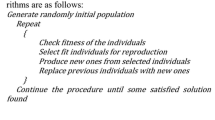Abstract
In this study it develops a superior transmission resource allocation method by using genetic algorithm. The convergence properties of genetic algorithm are employed to increase the transmission resource use efficiency of a base (station) to allow users to access wider bandwidth and to improve the system throughput and packet service rate. In this paper, it also studies the genetic algorithm convergent phenomena. The calculated system convergent time is significantly less than that of a long term evolution (LTE) frame duration. Finally, the system performances with and without implementing the genetic algorithm in resource allocations are simulated; their performances are compared to study the effectiveness of using the genetic algorithm in resource allocation.



















Similar content being viewed by others
References
UTRA-UTRAN Long Term Evolution (LTE) and 3GPP System Architecture Evolution (SAE). 3GPP LTA\_paper October 2006.
Base Station (BS) radio transmission and reception (Release 8), 3GPP TS 36.104 V8.5.0, March 2009.
Physical Channels and Modulation (Release 8), 3GPP TS 36.211 V8.6.0, March 2009.
Multiplexing and channel coding (Release 8), 3GPP TS 36.212 V8.6.0, March 2009.
Physical layer procedures (Release 8), 3GPP TS 36.213, V8.6.0, March 2009.
Physical layer-measurements (Release 8), 3GPP TS 36.214, V8.6.0, March 2009.
Beh, K. C., Armour, S., Doufexi, A. (2008). Joint time-frequency domain proportional fair scheduler with HARQ for 3GPP LTE Systems. In IEEE 68th vehicular technology conference, 2008. VTC 2008-Fall (pp. 1–5, 21–24), September 2008.
Dahlman, E. (2007, March). LTE-3G long term evolution. Expert Radio Access Technologies Ericsson Research.
Lee, Y.-H., Tseng, H.-W., Lee, W.-C., Lin, J.-Y., Jan, Y.-G., & Tsao, H.-W. (2012). The measurement and analysis of WiMAX base station signal coverage. Progress in Electromagnetics Research C, 25, 223–232.
Tachibana, T., Murata, Y., Shibata\({\dagger }\), N., Yasumoto, K., Ito, M. (2006). General architecture for hardware implementation of genetic algorithm. In IEEE symposium on field-programmable custom computing machines (FCCM 2006 14th Annual), Napa, California, pp. 291–292.
Tseng, H.-W., Lee, Y.-H., Lin, J.-Y., Lo, C.-Y., & Jan, Y.-G. (2012). Performance analysis with coordination among base stations for next generation communication system. Progress In Electromagnetics Research B, 36, 53–67.
Thomson, P., Miller, J. F. (1994). Optimization techniques based on the use of genetic algorithms (GAs) for logic implementation on FPGAs. In IEE colloquium on software support and CAD techniques for FPGAs, pp. 4/1–4/4.
Vega-Rodríguez, M. A., Gutiérrez-Gil, R., Ávila-Román, J. M., Sánchez-Pérez, J. M., Gómez-Pulido, J. A. (2005). Genetic algorithms using parallelism and FPGAs: The TSP as case study. In International conference workshops on parallel processing, (ICPP 2005), Oslo, Norway, pp. 573–579.
Tseng, H.-W., Chou, Y.-H., Chuang, M.-H., Lee, Y.-H., Sheu, S.-T., & Jan, Y.-G. (2008). Design and implementation of subchannelization scheduler in IEEE 802.16 broadband wireless access systems. Journal of the Chinese Institute of Engineers, 31(6), 967–976.
Tseng, H.-W., Chuang, M.-H., Lee, Y.-H., Sheu, S.-T., & Wang, Y.-K. (2008). Application of hardware architecture of genetic algorithm for optimal packet scheduling. International Journal of Fuzzy Systems, 10(3), 206–2021.
Lee, Y.-H., Jan, Y.-G., & Tseng, H.-W. (2005). Hardware implementation of QoS scheduling for WiMAX system by using genetic algorithm. International Journal of Fuzzy Systems, 7(4), 191–198.
Zhe, L., He, Z., Wu, W., Wang X., (2007). A simplified layered QoS scheduling scheme in OFDM networks. In IEEE 66th vehicular technology conference, 2007, VTC-2007 Fall, 2007, (pp. 1842–1846), September 30–October 3 2007.
Wernersson, M., Wänstedt, S. Synnergren, P. (2007). Effects of QoS scheduling strategies on performance of mixed services over LTE. In IEEE 18th international symposium personal, indoor and mobile radio communications, 2007, PIMRC 2007, (pp. 1–5), 3–7 September 2007.
Hu, H., Chen, H.-H., Guo, K., & Weckerle, M. (2007). Cross-layer adaptive resource allocation for OFDM systems with hybrid smart antennas. IET Communications, 1(5), 831–837.
Kwon, H., Lee, B. G. (2008). A resource allocation with balanced data throughput and power consumption under QoS constraint in MIMO interference systems: A noncooperative game approach. In IEEE international conference on communications, 2008. ICC ’08. (pp. 5123–5127), 19–23 May 2008.
Gui, B., Cimini, L. J. Jr. (2008). Resource allocation algorithms for multiuser cooperative OFDMA systems with subchannel permutation. In 42nd annual conference on information sciences and systems, 2008. CISS 2008. (pp. 692–697), 19–21 March 2008.
Chiu, C. C., Chen, C. H., Liao, S. H., & Chen, K. C. (2012). Bit error rate reduction by smart UWB antenna array in indoor wireless communication. Journal of Applied Science and Engineering, 15(2), 139–148.
Assumptions/parameters for system level evaluation of LBS performance, LBS Evaluation Group v0.3, September 2009.
IEEE C802.16m-09/2196, Performance of TDOA based on LBS evaluation group assumptions/parameters, IEEE 802.16 Broadband Wireless Access Working Group.
IEEE 802.16m-08/004r2, IEEE 802.16m evaluation methodology document (EMD). IEEE 802.16 Broadband Wireless Access Working Group.
Author information
Authors and Affiliations
Corresponding author
Rights and permissions
About this article
Cite this article
Tseng, HW., Lee, YH., Lo, CY. et al. Applying Genetic Algorithms to the Data Traffic Scheduling and Performance Analysis of a Long-Term Evolution System. Wireless Pers Commun 81, 387–403 (2015). https://doi.org/10.1007/s11277-014-2135-y
Published:
Issue Date:
DOI: https://doi.org/10.1007/s11277-014-2135-y




